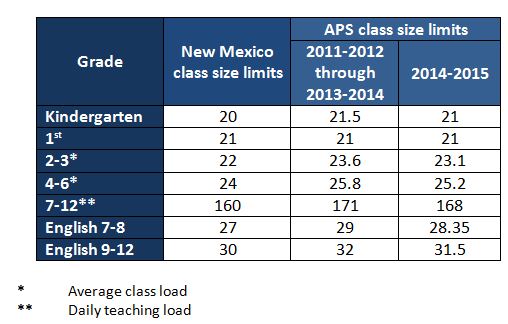This month’s Catching
up on Contracts reports on contract changes in five districts in our Teacher
Contract Database: San Francisco Unified School District,
Albuquerque Public Schools,
Brevard County School District,
Elgin School District U-46
and Tulsa Public Schools.
San
Francisco Unified School District, July 1, 2014 through June 30, 2017
The most notable changes in San Francisco’s latest contract
are in the increases in base salaries for full-time and substitute teachers.
The district is also ushering in changes to teachers’ preparation time.
Salary and benefits
Between July 1, 2014 and January 1, 2017, teachers receive a
12 percent cost-of-living increase in salaries, spread out over the term of the
contract as follows:
- July 1, 2014: 2 percent
- January 1, 2015: 2 percent
- July 1, 2015: 1.5 percent
- January 1, 2016: 1.5 percent
- July 1, 2016: 2.75 percent
- January 1, 2017: 2.25 percent
The contract provides greater incentive to give timely
notice of retirement. If teachers who plan to retire on June 30 give notice by
February 1, they receive $1,000; they receive $500 if they give notice by March
1. Previously, the stipend was $600 for notice by March 1.
Substitute teachers
It
is no secret that many districts around the country are facing a shortage
of substitute teachers, and as a November 2014 San Francisco Gate article
reported, San Francisco is no
exception. A fairly significant increase in pay for substitute teachers may help
alleviate the shortage:

Substitutes
begin on Level 1 unless they have worked more than 70 days for the two previous
consecutive school years. Once they qualify for Level 2, they are paid the
higher rate retroactively to the beginning of the year. They revert to the
Level 1 if a minimum of 71 days is not reached in any school year. For
substitutes in the same assignment more than 10 consecutive days, the daily
bonus rate is retroactive to the first day of that assignment.
Preparation time: The latest contract
more than doubles the amount of duty-free preparation time granted to
elementary teachers, jumping from 60 to 150 minutes each week.
Albuquerque
Public Schools (NM), July 1, 2014 – June 30, 2015
In Albuquerque, the latest contract
changes center around salary increases within its performance-pay salary
structure and a gradual return to state-level class size limits.
Salary
Albuquerque’s latest contract brings
salary changes; but first, a bit of background is needed in order to understand
the structure of these changes:
- New
Mexico offers a 3-tiered licensure system
which assigns base salaries to each level of teaching license. Advancement to a
higher licensure level is dependent on performance and a review of the
teacher’s professional development record. Within each licensure level, a
teacher’s salary increases based on seniority and advanced degrees. There are
more significant increases in salary when a teacher advances to a new licensure
level.
In May, 2014, New Mexico lawmakers voted to give teachers a 3 percent raise and
increased the base pay of teachers on level 1 by $2,000. Albuquerque negotiated a $2,000 raise for teachers on levels 2 and
3 as well, taking the base pay at each level to $32,000, $42,000 and $50,000,
respectively.
Teachers who already make the new
minimum salary or greater receive a 3 percent negotiated raise. Those who are
below the new minimum at each tier will get larger percentage raises to bring
them up to the new floor. For example, a level 2 teacher making $40,000
receives about a 5 percent raise to meet the new minimum of $42,000.
Class size
Due
to funding and budget limitations, Albuquerque
Public Schools (APS) received a waiver from the state in 2011 to exceed the
state’s class size limitations. Albuquerque
is now inching its way back to the pre-waiver class sizes this year.

Brevard
County School District (FL), July 2, 2014 – June 20, 2015
In Brevard, contract changes cover grievance and benefits;
however, the most interesting changes are in the district’s performance-pay
salary structure.
Salary
Teachers have the option to move to a new
pay-for-performance salary schedule or to remain on the grandfathered schedule.
This is a one-time opportunity; once a teacher selects either option, he/she
can’t switch to the other salary plan.
Interestingly though, there is very little difference
between the grandfathered schedule and performance-pay schedule with regard to how much teachers are paid. Like
previous years, teachers on both schedules receive bonuses for higher
evaluation ratings; specifically, those rated effective receive a $750 bonus
while those rated highly effective receive a $1,000 bonus. The difference
between the schedules in bonus amounts comes down to $1: highly effective
teachers now earn $1 more than teachers on the grandfathered scheduled.
Otherwise, base pay remains the same on both schedules.
The big differences the latest contract brings have to do
with how base pay is calculated and how teachers move along the salary
schedule. A teacher’s base salary is determined by adding his/her base salary
from the previous year to any performance bonuses earned. Additionally, movement
on both salary schedules is now dependent on performance, not seniority.
Teachers did not receive a cost-of-living increase this
year.
Grievances
The
grievance process has changed slightly within the new contract. In addition to
the players changing slightly, teachers now have fewer days to file a grievance: 14 days (10 school days) compared to the
previous 25 days (18 school days) they
had under the last contract.

Benefits
The district’s
contribution to the health insurance premium for employee-only coverage has
dropped to 85 percent of the cost of the premium, down from 91 percent in 2013.
However, the district’s maximum dollar contribution to health insurance did increase
from $544 to $614 per month.
Elgin
School District U-46 (IL), August 16, 2014 – August 11, 2017
Elgin District U-46
teachers will see a cost-of-living increase this year; but the more interesting
changes are within the district’s collaborative planning time and layoff and
recall policies.
Salary
This school year,
teachers receive a 2.5 percent cost-of-living adjustment.
Collaborative planning time
A new policy requires a more structured collaborative
planning time. The previous contract called for 240 minutes of collaborative
planning time each month with the exception of December (120 minutes), which could
be used in a wide variety of ways. The current contract introduces “Professional
Practice Days” and “District Collaborative Days,” each of which encompass
50 percent of a teacher’s total collaborative planning time.
On Professional Practice Days, teachers participate in a
collaborative activity with a group of colleagues. The focus is on students’ needs
through analysis of student growth, professional practice and curriculum
development and implementation.
On District Collaborative Days, the district assigns
activities aligned to the District Improvement Plan and the work of the
District Professional Development Committee and Instructional Council.
The total collaborative planning time must not exceed 10
days for each teacher.
Layoffs
Previously state law only allowed
teachers with the two highest evaluation ratings to be given recall rights
after layoffs. A recent change in the law now extends recall rights to teachers
who received one summative rating of “needs improvement” and one
summative rating of “proficient” or “excellent” on the
previous two evaluations. However, teachers with the lower evaluation ratings maintain
recall rights for six months, as opposed to the full year granted to higher-rated
teachers.
Tulsa Public Schools (OK), July 1, 2014 – June 30, 2015
There
isn’t much to report in Tulsa’s latest contract, except for its latest
cost-of-living increase in teacher salaries: this school year, teachers receive
a 0.3 percent cost-of-living adjustment. However, this really only impacts
teachers with nearly 30 years or more experience, as salaries on each step remained
the same from last year to this year except for steps 27 and higher on the
salary schedule.
